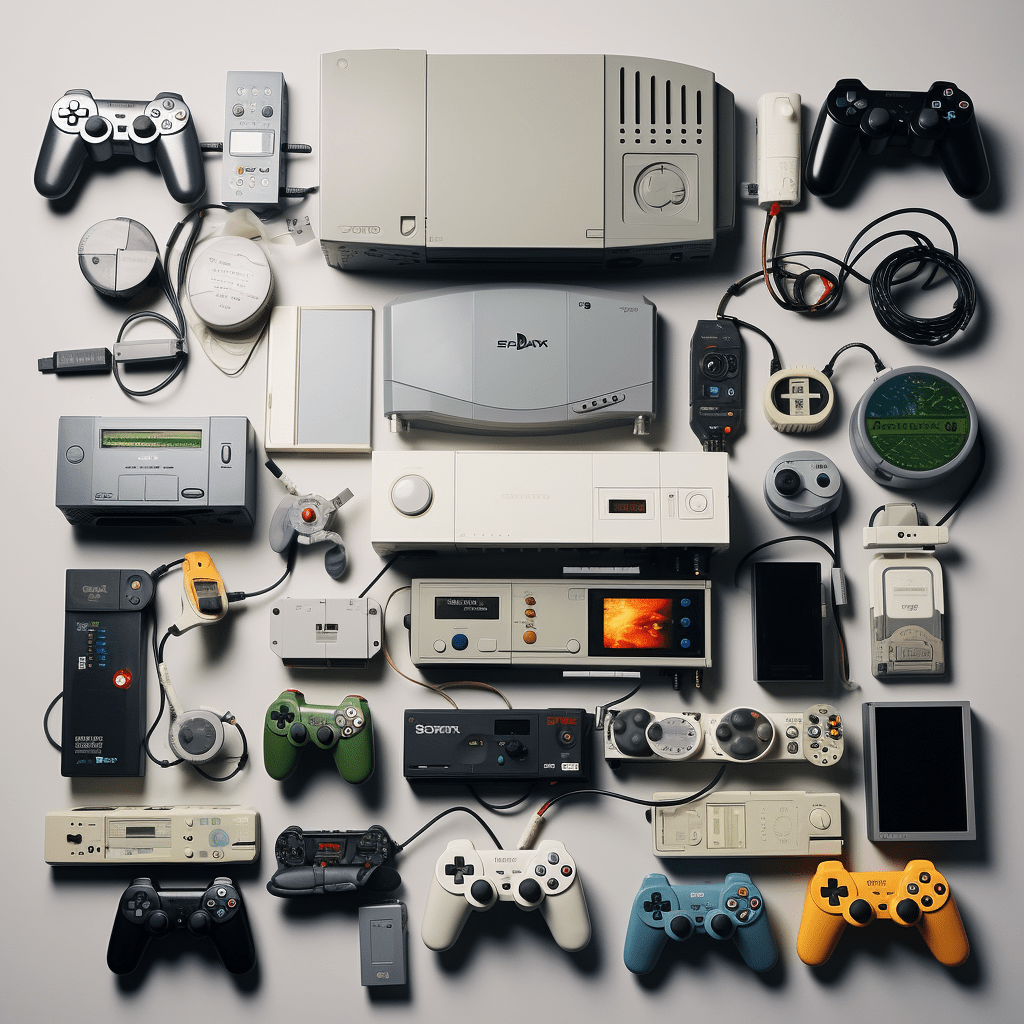Introduction
Console Gaming: A Journey Through Time
Console gaming refers to playing video games on dedicated gaming consoles, which are specifically designed for gaming purposes. These consoles are connected to a television or monitor and are controlled using handheld controllers. Console gaming has become a popular form of entertainment, offering immersive gameplay experiences and cutting-edge technology. Over the years, console gaming has evolved significantly, leading to advancements in technology, gameplay, and user experience.
The Early Days of Console Gaming
The Birth of Console Gaming
The Magnavox Odyssey, released in 1972, is considered the first home video game console. It featured simple games like Pong and Hockey, which could be played on a television screen. This marked the birth of console gaming and laid the foundation for future advancements in the industry.
Pong: The Game-Changer
Pong, released in 1972 by Atari, became a sensation and popularized arcade-style gaming. It was a simple tennis game that could be played on a home console, bringing the arcade experience to living rooms across the world. Pong’s success paved the way for more advanced gaming consoles and a growing demand for home gaming systems.
The Atari 2600 Revolution
In 1977, Atari released the Atari 2600, the first home gaming console to achieve widespread success. It featured interchangeable game cartridges, allowing players to expand their gaming library. The Atari 2600 revolutionized the gaming industry and set the stage for the golden age of console gaming.
The Golden Age of Console Gaming
The NES Era
The Nintendo Entertainment System (NES), released in 1985, revitalized the gaming industry after the video game crash of 1983. It introduced iconic games like Super Mario Bros. and The Legend of Zelda, which became household names. The NES’s success led to the resurgence of console gaming and established Nintendo as a dominant player in the industry.
Sega’s Genesis of Innovation
The Sega Genesis, released in 1988, introduced 16-bit graphics and sound, pushing the boundaries of console gaming. It became a fierce competitor to the NES, offering popular titles like Sonic the Hedgehog. The Genesis vs. NES rivalry fueled innovation and creativity in game development.
The Super Nintendo Experience
The Super Nintendo Entertainment System (SNES), released in 1990, intensified the battle for console supremacy. It featured enhanced graphics, improved sound, and iconic games like Super Mario World and The Legend of Zelda: A Link to the Past. The SNES vs. Genesis rivalry defined the golden age of console gaming and provided gamers with unforgettable experiences.
The Transition to 3D Gaming
PlayStation: A New Dimension
The Sony PlayStation, released in 1994, marked a significant shift in console gaming. It introduced CD-based gaming, allowing for larger and more immersive games. The PlayStation’s success paved the way for 3D graphics and cinematic storytelling in gaming.
Nintendo’s Leap into 3D
The Nintendo 64, released in 1996, brought 3D graphics to the forefront with games like Super Mario 64 and The Legend of Zelda: Ocarina of Time. It featured innovative controller design and multiplayer capabilities, setting new standards for console gaming.
Sega’s Struggles
The Sega Saturn, released in 1994, struggled to compete in the 3D gaming market. Despite its technical capabilities, it faced challenges in game development and marketing, ultimately leading to its decline.

The Rise of Online Gaming
Dreamcast’s Online Revolution
The Sega Dreamcast, released in 1998, was the first console to feature built-in online capabilities. It allowed players to connect to the internet and play games with others around the world. Although the Dreamcast was short-lived, it laid the foundation for online gaming on consoles.
PlayStation 2: Expanding Online Gaming
The PlayStation 2, released in 2000, expanded online gaming with the introduction of the Network Adapter. It offered a wide range of online multiplayer games and paved the way for the future of console gaming.
Xbox Live: Redefining Online Play
The Xbox, released in 2001, revolutionized online gaming with the introduction of Xbox Live. It provided a unified online gaming platform, allowing players to connect, compete, and communicate with each other. Xbox Live set the standard for online gaming services and became a key feature of modern consoles.
The Modern Era of Console Gaming
Xbox 360: High-Definition Gaming
The Xbox 360, released in 2005, ushered in the era of high-definition gaming. It featured powerful hardware, online connectivity, and a vast library of games. The Xbox 360’s success solidified Microsoft’s position in the console market.
PlayStation 3: Multimedia Hub
The PlayStation 3, released in 2006, integrated multimedia features like Blu-ray playback and online streaming services. It offered a diverse range of gaming experiences and became a multimedia hub for many households.
Wii’s Motion-Controlled Revolution
The Nintendo Wii, released in 2006, revolutionized gaming with its motion-controlled gameplay. It introduced a new way of interacting with games, appealing to a broader audience. The Wii’s innovative approach to gaming made it a commercial success.
The Current State of Console Gaming
PlayStation 4: Dominance Continues
The PlayStation 4, released in 2013, has dominated the console market with its powerful hardware, exclusive titles, and robust online services. It continues to push the boundaries of gaming technology and offers a wide range of entertainment options.
Xbox One: The Entertainment Hub
The Xbox One, released in 2013, focuses on multimedia and entertainment, offering features like live TV integration and streaming services. It aims to be the center of the living room entertainment experience.
Nintendo Switch: Hybrid Innovation
The Nintendo Switch, released in 2017, introduced the hybrid console concept, allowing players to switch between handheld and docked modes. It offers unique gameplay experiences and has gained a loyal following.
The Future of Console Gaming
Virtual Reality (VR) and Gaming
Virtual reality (VR) is expected to have a significant impact on console gaming. With the introduction of VR headsets, players can immerse themselves in virtual worlds and experience games in a whole new way.
Cloud Gaming: A Game Changer
Cloud gaming, which allows players to stream games over the internet, has the potential to change the way games are accessed and played. It eliminates the need for physical discs or downloads, making gaming more accessible and convenient.
Artificial Intelligence (AI) in Gaming
Artificial intelligence (AI) is also expected to enhance gameplay experiences. AI-powered NPCs (non-playable characters) can provide more realistic and dynamic interactions, creating more immersive and engaging worlds.
The Impact of Console Gaming on Society
Cultural Significance
Console gaming has had a profound cultural significance, shaping the way we consume entertainment and interact with technology. It has influenced other forms of media, such as movies and music, with many popular franchises crossing over into different mediums.
Positive and Negative Effects
Console gaming has both positive and negative effects on individuals and society. On one hand, it promotes problem-solving skills, teamwork, and creativity. On the other hand, excessive gaming can lead to addiction, social isolation, and health issues.
Conclusion
The Ever-Evolving World of Console Gaming
The evolution of console gaming has transformed the gaming industry, pushing the boundaries of technology, gameplay, and user experience. From the early days of simple tennis games to the immersive worlds of virtual reality, console gaming continues to innovate and captivate players worldwide. As technology advances and new trends emerge, the future of console gaming holds exciting possibilities for the gaming landscape.
FAQ
Q1: What is console gaming?
A1: Console gaming refers to playing video games on dedicated gaming consoles designed for gaming purposes, typically connected to a TV or monitor and controlled using handheld controllers.
Q2: When was the first home video game console released?
A2: The first home video game console was the Magnavox Odyssey, released in 1972.
Q3: What marked the golden age of console gaming?
A3: The golden age of console gaming was marked by intense competition between consoles like the NES, Sega Genesis, and SNES, leading to iconic games and innovations.
Q4: How did online gaming change the console gaming landscape?
A4: Online gaming, introduced by consoles like the Sega Dreamcast and Xbox, allowed players to connect and play games over the internet, revolutionizing multiplayer experiences.
Q5: What are the key features of the modern era of console gaming?
A5: The modern era of console gaming includes high-definition gaming, multimedia integration, motion-controlled gameplay, and online services like Xbox Live and PlayStation Network.







